| Figure 1 is based on a
photograph
of a Bamum Royal Bodyguard in parade dress. King Njoya was given a gift
of at least a dozen elaborate eagle helmets, cuirasses
and swords from the Prussian Garde du Corps Cuirassier Regiment
(see right) by
their colonel in chief, Kaiser Wilhelm II. These items were much
prized by the Bamum and were worn by Njoya and his bodyguard on
parades. This guardsman wears one of the
Garde du Corps helmets (see right). The Garde du Corps were unique in that they replaced
the helmet spike on parade with a metal Prussian eagle. The
eagles of the Bamum guard in photographs appear to have been
damaged and some (like this one) are bent slightly backwards or
sideways. The cuirass is again the Prussian cavalry model.
The tunic is Bamum-made based on the style of the
Prussian cuirassiers with the striped front but without Swedish
style cuffs. In the original photograph the tunic appears to be of
a dark shade. It may possibly have been made from red velvet, of
which the Bamum had received some quantity from trade. Bamum
guardsmen were also described by the German missionary, Martin Göhring
in 1906 as wearing uniforms of red velvet. The trousers are also
Bamum made and appear white in the original photograph.
This guardsman is barefooted as were many of the Bamum army. He is
armed with a German Cavalry sword, the scabbard of which is
incorrectly fixed to the retaining belt of the cuirass.
Figure 2 is based on a
photograph
of a Bamum Cavalryman of the Guard. Their uniforms were based on
photographs King Njoya had seen in the magazine 'Die Woche'
of the Prussian Leib-Hussars (1st and 2nd Imperial German Life-Hussar
Regiments). At first glance the uniforms appear to be genuine
German hussar tunics (see right) but closer examination shows the
tunic length is too long, the braiding is more elaborate,
larger and slightly sloped and uneven. The braiding itself while based on the German (or
originally Hungarian design) incorporates aspects of Bamum
artwork especially in the additional sleeve embroidery and may
have had glass beadwork incorporated into it. The tunic may also have
had Bamum style embroidery on the back. The shoulder straps
are of coloured beadwork. This cavalryman has been awarded a Bamum medal,
worn in imitation of German medal ribbons on the left breast.
These Bamum medals were larger than German medal ribbons, of three
coloured stripes (the darker in the centre) and more rigid than
normal medal ribbons.
The
imitation hussar busby is decorated with a looping pattern of
Bamum design (which is repeated on the sides and possibly rear)
and appears to be beaded as are the badges and insignia on it. The white plume
was based on the German design. Although German hussars wore
riding boots, the Bamum cavalry had only short ankle boots. German
boots were highly prized but the Bamum tailors also made leather
boots for Njoya and his army. This cavalryman is armed with a sabre, probably of German origin.
Figure 3 is based on a
photograph of King Njoya of Bamum
in 1914. King Njoya owned several uniforms, including a simple khaki
tunic with white tropical helmet, peaked field cap, Garde du Corps uniform and helmet and even had a crown made in imitation of the
German imperial crown. All these items were often worn with a mixture
of the richest Bamum traditional clothing and jewellery. On other occasions
he often wore simple Islamic
white robes, as worn by the Hausa (see right). After 1909 and the disarmament of his army he
(and his cavalry) always
wore Hausa robes.
In the photo upon which this
illustration was based, King Njoya wears the an officers uniform of
the Prussian Garde du Corps Cuirassier Regiment. The tunic was
white (or cream-white) with a red collar and red Swedish style cuffs
with white metal buttons, both with silver
double Litzen. The front of cuirassier tunic had concealed buttons
and a red false front with silver lace. Over the tunic he wears a
richly embroidered Bamum-made waistcoat. It is reasonable to assume the
plant-like patterns may have been in plant-like coloured silk such as green,
brown and red and decorated with coloured glass beadwork. On the waistcoat Njoya wears two Bamum medals, one
hanging on a ribbon is clearly based on German designs. He wears a
coloured sash at the waist and what may be a white leather cross belt from the Garde
du Corps. Njoya also often wore a coloured sash cross
the shoulder decorated with leopard's claws as a sign of his royalty.
His hat is a Bamum design, richly decorated with beads and jewellery all
of Bamum design and topped with a black plume. Although the
original photo only shows Njoya from the waist up, I have illustrated him
wearing leather riding boots with stirrups as he is seen in several other
photos. These were probably of German origin.
King Njoya, Fon of Bamum
(18??-1933, reigned 1886-1931) was in every sense of the term an enlightened despot.
He inherited the kingdom from his father Nsangu, in 1886 and immediately
encouraged arts and building projects. He had an ornate
brickwork palace built in Foumban based on German designs (see above
right). Perhaps his greatest
achievement was to invent and introduce the first written alphabet for
the Bamum language. He was keen to learn from neighbouring cultures
and assimilate them into Bamum culture. He converted to
Islam which he learned from Hausa contact in the North, although he
blended it with the old tribal ancestor worship. He welcomed German
and Swiss missionaries and regularly attended their meetings although
never became a Christian. When the French took over most of Cameroon in 1916, they considered Njoya a trouble maker.
In 1931 he
was arrested, deposed and exiled for life by the French. The monarchy was later restored in Bamum and Njoya's
descendants still reign to this day, albeit with no political power any
longer.
|
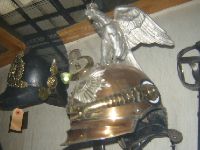
Prussian Garde du Corps Helmet
Musée Royale de l'Armée Collection
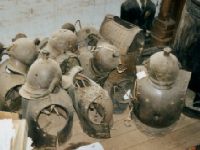
Njoya's Helmets Today
(See
Photos
from Foumban Page)
Photo copyright Arne Schöfert
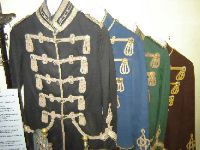
Genuine German Hussar Tunics
Musée Royale de l'Armée Collection
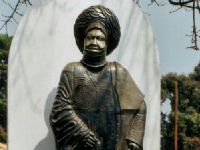
A Monument to Njoya in Foumban wearing Islamic
Hausa robes
(See
Photos
from Foumban Page)
Photo copyright Arne Schöfert
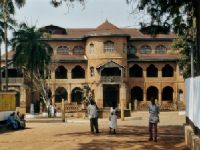
Njoya's Palace in Foumban
(See
Photos
from Foumban Page)
Photo copyright Arne Schöfert |
Figure 4 is based on a
photograph
of a Bamum Officer.
He wears a surprising amount of German uniform although Bamum
equivalents of most of these items were also made. The hat appears to
be a genuine Schutztruppe Südwester with Cameroon red edging and
hatband. Not fully visible in the original photo is the badge holding
up the right side of the brim. It may have been the original German
black/white/red cockade or a Bamum design. Bamum-made Südwesters were
less rigid in shape.
The tunic is a genuine German white
tropical tunic as issued to the Schutztruppe, or possibly the Cameroon
police as this tunic has no Schutztruppe blue piping. Bamum-made white
officers' tunics were longer with no pockets, and some had elaborate
embroidery on them. Note the medal similar to that
worn by the "hussar" in figure 2. Again it is of three striped cloth,
this time worn tucked into the front of the tunic between the second
and third buttons. The trousers are Bamum made and of dark material.
The puttees may have been early Schutztruppe issue in dark blue/grey,
or have been Bamum-made in a variety of colours. The original
photos shows them to be darker than the khaki uniforms worn by others
around them.
Figure 5 is based on a
photograph
of a Bamum Foot Soldier
taken during King Njoya's visit to
Governor Seitz in Duala, the
capital of Cameroon, in January 1908. He wears a Bamum made khaki
uniform closely modelled on that of the Schutztruppe. Note however
that the tunic is longer and has six buttons down the front (as
opposed to the four or five worn by Cameroon native Schutztruppe). The
shoulder straps are darker than the tunic (possibly red) with a beaded
trimming. NCOs wore chevrons similar to those of the Schutztruppe but
again made from coloured beads. The
trousers are matching and tucked into ankle boots with socks. Many
Bamum infantry were also barefoot.
The hat is a fez or tarbush in khaki
with Bamum emblems decorated on the front, sides and probably back.
The emblem of Bamum was a two headed python, with a head at both
ends of its body. On top of the fez is a curious point with a coloured top. Other photos of Njoya's foot soldiers
show them wearing similar khaki uniforms with various headgear. A fez
or tarbush similar to the one shown here is sometimes seen with a dark
band of braid sloping diagonally across it. A tall grenadier style
mitre cap (possibly copied from photographs of the Prussian Guard
Grenadier Regiments on parade) is worn by some soldiers in khaki with
similar decorations to the fez in this illustration. In other photos
Bamum soldiers wear
peaked field caps with light coloured hatbands or Bamum-made slouch
hats similar to the Schutztruppe Südwester.
Bamum foot soldiers were armed with a
variety of rifles, mostly obsolete percussion cap or flintlocks with
only a few dozen breech loading rifles between them.
Period Photographs
These photographs originally appeared
in "African Crossroads: Intersections between History and
Anthropology in Cameroon" (see
Book Reviews Page) and more
recently have been seen on
WikiCommons.
Three photographs of King Njoya in
Uniform.
The photograph above left shows King
Njoya c1907. He wears a locally made uniform in imitation of
European military fashions with a German heavy cavalry sword.
Photograph by Martin Göhring.
The photograph above centre shows
King Njoya in his German dress uniform c1907. He wears a genuine
Prussian Cuirassier helmet and tunic with locally made decorations.
Photographer unknown.
The photograph above right shows King
Njoya outside the Old Palace of Foumban, Bamum c1906. He wears a
uniform closely based on the Schutztruppe 1896 khaki tropical
uniform with officers shoulder boards and a tropical helmet. It most
likely locally made by the Bamum tailors but may include genuine
Schutztruppe items received as gifts.
Photograph delivered by Friedrich Lutz,
May 1906.
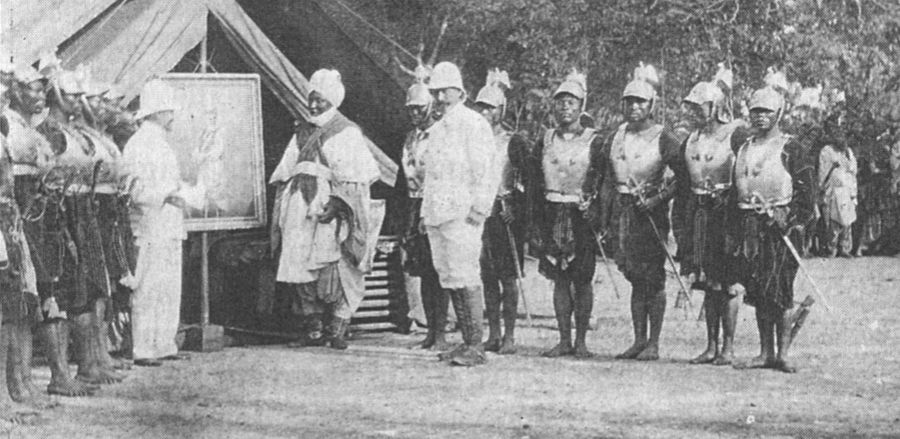
King Njoya receiving an oil painting
of Kaiser Wilhelm II in Bamum in 1906. The gift was in return for
his support in the German campaign against the Nso. Njoya wears
traditional Cameroon robes while his bodyguard wear Prussian
Cuirassier helmets and cuirasses. The two Schutztruppe officers wear
the white 1896 uniform with tropical helmets.
Photograph by Martin Göhring or
Lieutenant Edler von der Putlitz.
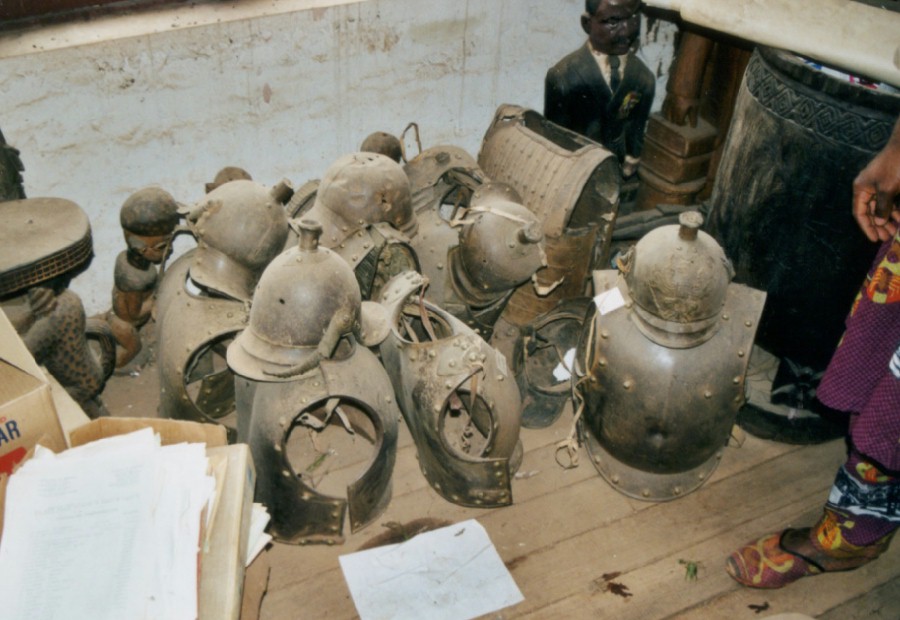
The old Prussian Guard du Corps
helmets and cuirasses once worn by King Njoya's bodyguard, now
gathering dust in a storage room in the palace museum. Note the
Prussian eagle that can still be made out on the helmet on the far
right.
Photo
©
Arne Schöfert
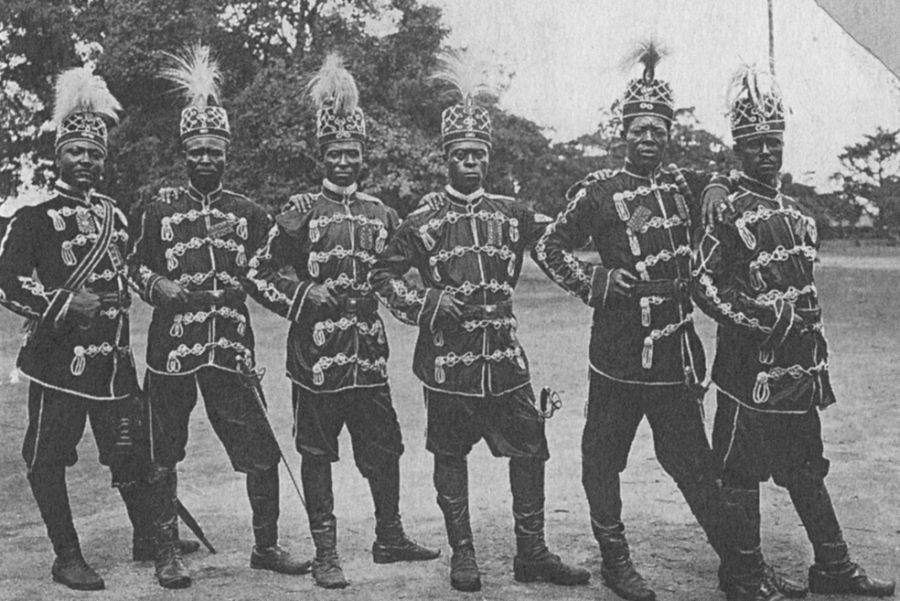
King Njoya (far left) and his
bodyguard soldiers in Bamum c1906. Their pose is in imitation of a
picture of Crown Prince Wilhelm of Germany and his comrades in the
Prussian Leib-Husaren. Njoya and his bodyguard wear hussar
uniforms locally made to match those of the Prussian Hussars.
Photo by Rudolf Oldenburg
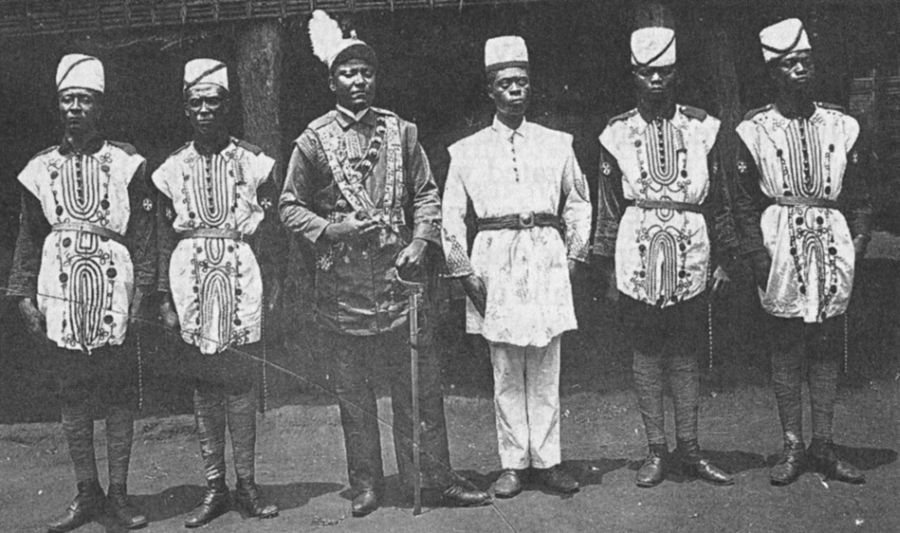
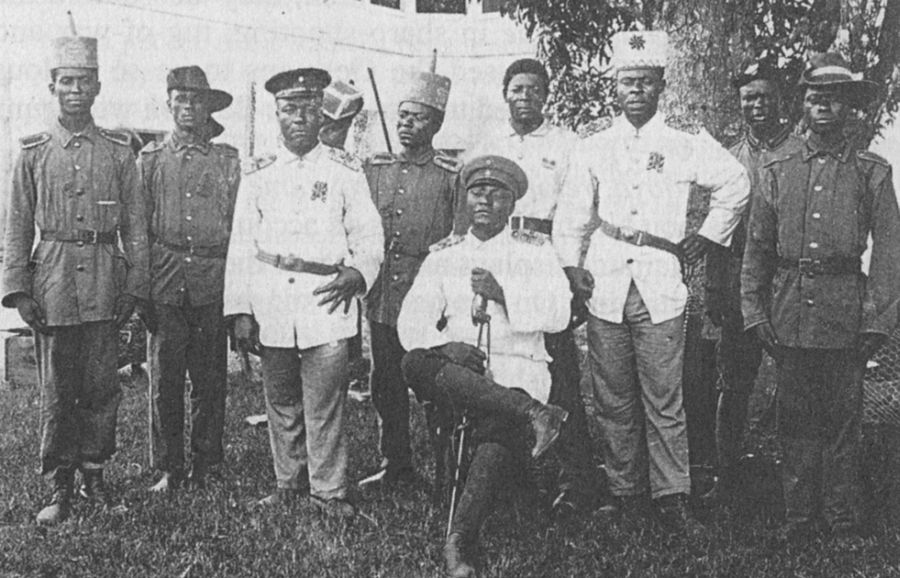
Interesting Links about King Njoya and
Bamum
Basel Mission Picture Archive-
featuring many photos of King Njoya and his entourage.
Bead Bugle - African Bead History-
Featuring an article on Bamum beadwork.
African Fonts- Bamum Script -
King Njoya's own invented alphabet.
Another excellent source of information
for this page was "African Crossroads- Intersections between History
and Anthropology in Cameroon" edited by Ian Fowler and David Zeitlyn.
See Book Reviews Page.
NB If searching the web please note
that names such as Njoya, Bamum and Foumban (the capital of Bamum) are sometimes spelled in
several different ways (eg. Njoya, Nyoja, Joja, and also Sultan Ibrahim Njoya
after his conversion to Islam; Bamum,
Bamoum,
and Bamoun; Foumban, Fumban and Fomban). This is partly to do with the
different eras of German and French colonialism and hence different
translations of African words. King Njoya himself of course, would have
written them in his own alphabet.
|